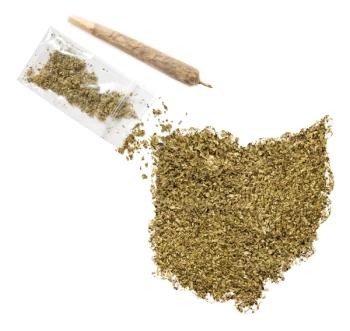
Cannabis Science and Technology
- September/October 2025
- Volume 8
- Issue 5
- Pages: 16-18
Beyond Cannabinoids: The Analytical Value of Terpene Chirality in Cannabis

Key Takeaways
- Terpenes' chirality in cannabis affects olfactory and biological properties, crucial for product authenticity and cultivar differentiation.
- Chiral gas chromatography enables enantiomeric resolution of monoterpenes, providing quantitative stereochemical profiling.
This article emphasizes the analytical value of terpene chirality in cannabis quality control. Many cannabis terpenes are chiral (have non-superimposable mirror images), and their enantiomeric distribution affects aroma, bioactivity, and product authenticity. Chiral gas chromatography (GC) is key to separating and quantifying these enantiomers, enabling more rigorous product standards.
With the expansion of regulated cannabis markets, quality control must extend beyond cannabinoid quantification into the characterization of secondary metabolites such as terpenes. Many cannabis terpenes exhibit chirality, giving rise to enantiomeric pairs. Each enantiomer can display distinct olfactory properties, biological activities, and biosynthetic origins, making stereochemistry a critical determinant of their functional roles. Their enantiomeric distribution therefore represents a powerful marker for product authenticity, cultivar differentiation and stability assessment. While the stabilities of Δ⁹-tetrahydrocannabinol and cannabidiol are well characterized, comparatively little is known about the enantiomeric stability of cannabis terpenes under storage, processing and environmental stress. This article reviews analytical methodologies for enantiomeric resolution of cannabis monoterpenes, with particular focus on chiral gas chromatography (GC) employing cyclodextrin-based stationary phases coupled to flame ionization detection (FID) or mass spectrometric (MS) detection. These approaches enable baseline separation of structurally similar enantiomeric pairs, including α-pinene, β-pinene, limonene, and linalool, providing the resolution necessary for quantitative stereochemical profiling. Expression of results as enantiomeric ratios (ER) or enantiomeric excess (ee) yields reproducible chemical fingerprints that can support cultivar authentication, detect adulteration, and establish more robust industry standards. By incorporating enantiomeric profiling into routine testing, laboratories can enhance the analytical rigor and reliability of cannabis quality control.
Introduction
The rapid expansion of regulated cannabis markets has intensified the demand for rigorous quality control measures that extend beyond conventional cannabinoid quantification. Previously, the focus was almost exclusively on the quantification of primary cannabinoids, most notably ∆9-tetrahydrocannabinol (THC) and cannabidiol (CBD) as proxies for potency and compliance. While this approach established a baseline for product standardization, it fails to capture the broader chemical complexity that ultimately defines cannabis quality. Increasing evidence underscores the role of secondary metabolites, particularly terpenes, in shaping product identity.
Terpenes are a structurally diverse class of volatile hydrocarbons biosynthesized from isoprene (C₅H₈) units via the mevalonate (MVA) and methylerythritol phosphate (MEP) pathways (1). In cannabis, they represent the dominant volatile fraction of glandular trichome secretions and are the primary determinants of cultivar-specific aroma and flavor. Beyond their sensory contributions, terpenes function ecologically as defense agents against herbivores, pathogens, and abiotic stressors, while also contributing to the pharmacological activity of cannabis through receptor interactions and synergism with cannabinoids (2). Consequently, detailed terpene profiling is increasingly recognized as a critical marker for authenticity, cultivar differentiation, and quality assessment.
Chirality in Cannabis Terpenes
Chirality describes a fundamental molecular property: spatial asymmetry that prevents mirror-image conformers from achieving congruence through any spatial transformation. Molecules that exhibit this property are termed chiral, and the two non-superimposable mirror images are referred to as enantiomers (3,4).Many terpenes found in cannabis display stereochemical chirality, and these chemically distinct forms can result in varied biological effects notably as seen in limonene—where (R)- and (S)-enantiomers yield citrus and pine aromas, respectively, and in linalool, whose enantiomers differ in both scent and pharmacological effects. Similarly, both α- and β-pinene occur as enantiomeric pairs, with each enantiomer exhibiting distinct olfactory characteristics and biological activities (5). The enantiomeric distribution of terpenes therefore represents a sensitive indicator of product authenticity, cultivar differentiation, and chemical stability. While the stability of major cannabinoids such as THC and CBD is well characterized, comparatively little is known about the stability of terpene enantiomers under storage, processing, and environmental stress conditions.
Advanced Analytical Chemistry for Terpenes
Terpene analysis in cannabis presents unique analytical challenges due to their volatility, structural diversity, and frequent occurrence as enantiomeric pairs. Gas chromatography–mass spectrometry (GC–MS) remains the primary method for volatile terpene profiling, providing high resolution of structural isomers such as α- and β-pinene. The approach is supported by extensive spectral libraries that enable robust compound identification. However, GC methods are not without limitations: thermally labile oxygenated terpenes such as linalool can undergo degradation at high injector or column temperatures, and enantiomers cannot be distinguished without specialized chiral GC stationary phases or advanced two-dimensional separations (GC×GC–MS) (6,7). These multidimensional systems improve peak capacity and resolve trace terpenes in the complex cannabis
resin matrix.
Mass spectrometry (MS) itself underpins most terpene analysis workflows. In MS, analytes are ionized under vacuum, producing charged fragments that are separated according to their mass-to-charge (m/z) ratios. The resulting fragmentation patterns yield structural information that can be matched to databases or used to infer molecular features. When coupled with chromatographic methods, MS enables both qualitative and quantitative assessment of terpenes.
To address GC limitations, supercritical fluid chromatography–mass spectrometry (SFC–MS) has gained attention. Using supercritical CO2, often with polar modifiers, SFC operates under mild thermal conditions that minimize degradation of volatile monoterpenes and facilitate separation of less volatile sesquiterpenes. When paired with supercritical fluid extraction (SFE), SFE–SFC–MS allows direct extraction and analysis of terpenes and cannabinoids from plant matrices, preserving highly volatile constituents and reducing sample preparation steps (8).
Conclusion
The chemical landscape of commercial cannabis is defined by more than just cannabinoid content; it is intrinsically linked to the complex profile of secondary metabolites, particularly the chiral terpenes. The current review highlights that enantiomeric profiling provides a level of analytical sophistication essential for robust quality control in a maturing, regulated market. Standard achiral methods, while adequate for basic terpene quantification, fail to capture the critical stereochemical nuances that influence a product's aroma, biological activity, and authenticity. The adoption of chiral gas chromatography (GC), particularly when utilizing cyclodextrin-based columns coupled with sensitive detection methods like MS, offers the requisite analytical rigor to resolve and quantify monoterpene enantiomers. By transitioning from simple total terpene measurements to reporting reproducible metrics such as enantiomeric ratios (ER) and enantiomeric excess (ee), the cannabis industry can establish a new gold standard for product differentiation and consumer confidence. Future research must now focus on applying these advanced techniques to systematically investigate the stability of terpene enantiomers across various post-harvest, extraction, and formulation processes. Incorporating stereochemical analysis into routine testing is not merely an enhancement of quality assurance; it is a vital step toward fully characterizing cannabis products and ensuring that chemical integrity matches market claims.
References
- Sommano, S. R.; Chittasupthasri, C.; Ruksiriwanich, W.; Jantrawut, P. The cannabis terpenes. Molecules. 2020, 25 (24), 5792. DOI: 10.3390/molecules25245792
- Toffolatti, S. L.; Maddalena, G.; Passera, A.; Casati, P.; Bianco, P. A.; Quaglino, P. Role of Terpenes in plant defense to biotic stress. In Biocontrol Agents and Secondary Metabolites; Elsevier: 2021; pp 401–417.
- Peluso, P.; Chankvetadze, B. Recognition in the domain of molecular chirality: from noncovalent interactions to separation of enantiomers. Chem. Rev. 2022, 122, 13235–13400.
- Zhao, Y.; Zhu, X.; Jiang, W.; Liu, H.; Sun, B. Chiral recognition for chromatography and membrane-based separations: recent developments and future prospects. Molecules 2021, 26, 1145.
- Salehi, B.; Upadhyay, S.; Erdogan Orhan, I.; Kumar Jugran, A.; Jayaweera, L. D.; Dias, S. A.; Sharopov, F.; Taheri, Y.; Martins, N. et al. Therapeutic potential of α-and β-pinene: A miracle gift of nature. Biomolecules 2019, 9, 738.
- Paryani, T. R.; Sosa, M. E.; Page, M. F.; Martin, T. J.; Hearvy, M. V.; Ojeda, M. A.; Koby, K. A.; Grandy, J. J. et al. Nonterpenoid Chemical Diversity of Cannabis Phenotypes predicts differential aroma characteristics. ACS Omega 2024, 9, 28806–28815.
- Rantaša, M.; Slaček, G.; Knez, Ž.; Marevci, M. K. Supercritical fluid extraction of cannabinoids and their analysis by liquid chromatography and supercritical fluid chromatography: A short review. J. CO2 Util. 2024, 86, 102907.
- Weston-Green, K.; Chunas, H.; Jimenez Naranjo, C. A review of the potential use of pinene and linalool as terpene-based medicines for brain health: discovering novel therapeutics in the flavours and fragrances of cannabis. Front. Psychiatry 2021, 12, 583211.
- Sharopov, F.; Taheri, Y.; Martins, N.; Baghalpour, N.; Cho, W.; Sharifi-Rad, J. Therapeutic potential of α-and β-pinene: A miracle gift of nature. Biomolecules 2019, 9, 738. (Duplicate of reference 5, but formatted for completeness)
- Ibrahim, E. A.; Radwan, M. M.; Gul, W.; Majumdar, C. G.; Hadad, G. M.; Abdel Salam, R. A.; Ibrahim, A. K.; Ahmed, S. A. et al. Quantitative determination of cannabis terpenes using gas chromatography-flame ionization detector. Cannabis Cannabinoid Res. 2023, 8, 899–910.
- Thomas, A.; Bessiere, Y. Limonene. Nat. Prod. Rep. 1989, 6, 291–309.
About the Columnist
Dr. Zacariah Hildenbrand is a research Professor at the University of Texas at El Paso, the principal founder of Inform Environmental, a partner of Medusa Analytical, and is a director of the Curtis Mathes Corporation (OTC:CMCZ). Direct correspondence to:
About the Guest Co-Author
Hannia Mendoza-Dickey has a MS degree in Chemistry and is the founder of Green Matter Consulting.
About the Guest Co-Author
Robert Manes is the CEO and CTO of the publicly-traded Curtis Mathes Corporation, where he specializes in the creation and manufacture of frequency-specific lighting for horticulture and phototherapy purposes.
How to Cite this Article
Hildenbrand, Z., Mendoza-Dickey, H., Manes, R., Beyond Cannabinoids: The Analytical Value of Terpene Chirality in Cannabis, Cannabis Science and Technology, 2025, 8(5), 16-18.
Articles in this issue
about 1 month ago
The Art of the Pre-Rollabout 1 month ago
The Essence of Cannabis and the Compounds Behind ItNewsletter
Unlock the latest breakthroughs in cannabis science—subscribe now to get expert insights, research, and industry updates delivered to your inbox.





